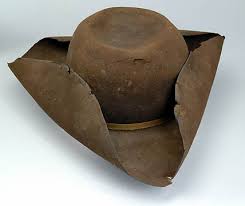I’ve written about how to make pirate hats, but I’ve never written
about the actual fashion of pirate hats. By my reckoning, the Golden Age of Piracy
spanned the time between 1690 and 1720. Fashion in mens’ hats changed over this
time, but some things stayed the same.
To begin with, the basic structure of the man’s hat had not
changed much since the early 1600’s. The basis of men’s hats was a large piece
of heavy felt, shaped to the top of the head, with a wide brim. Some of the
hats were round in the crown, and some were flat topped.
A major fashion divergence (in England) took place during
the age of the Puritans and the English Civil War. Put very simply, this was a
conflict between religious conservatives (who strongly supported a “plain”
lifestyle and dress code) and Royalists, supporters of the English king, who espoused a
more luxurious lifestyle.
Of course, the political clash was much more complex. But
the two sides showed their loyalties by their dress, especially their hats. In
fact, the conservative religious side became known as “roundheads” for their tendency
to wear their hats with the brims flat and the round crowns unadorned. In
contrast, the Cavaliers adorned their hats and lavishly, especially with
plumes. They also turned up the brims of their hats in a fashionable manner.
By the late 1600’s, the style – for the stylish – was to turn
up the brim of the hat in 3 sections, making the early form that we know as the
“tricorn” – literally “three horned” from the three points made by the
turned-up sides.
 |
| A very battered fabric tricorn |
This is the form that we most strongly associate with
pirates. But pirates did not in any way have a monopoly on these hats. In fact,
throughout most of the Golden Age, pirates wore hats of this shape simply
because, if a person set out to buy a “men’s hat” this is what they would be
offered.
The style had first come into use during warfare between
France and Spain during the 1650’s. The style then moved to France where it
became “fashionable.”
The English tended to offer these hats plain- with no more
than a contrasting colored trim around the edge of the brim. Italians tended
more toward metallic trims around the brims, while the French added a fluffy
feathered detail all around the edge of the brim.
Now, how did pirates use these hats?
In the first place sailors did not wear their hats in the
same way as landsmen. Today, we see hats worn always with one of the tips
pointing perfectly forward, directly over the wearer’s nose. But men did not
always wear their hats this way. For example, soldiers who marched with a rifle
or musket on their shoulders, put the flat side of the hat on that side. This made
it less likely that they would knock the hat off with the musket. It also gave
the front of the hat an odd, lopsided look, with the front point off center.
Sailors wore their hats with a flat side in front, and a
point in the back. This looks strange to us, but it allowed the wearer to work
in close quarters without knocking the hat off. The point coming over the owner’s
neck may also have offered some protection from the sun.
However, hats were expensive, and many plain sailors wore a
simple fabric cap with a narrow brim. Owning a real hat would have been a step
up that pirates might aspire to.
Working pirates also probably wore some kind of bandana or
fabric headband. This was for the pragmatic reason of keeping sweat out of the
eyes. Pirates had more money to buy scarves with, and may also have cut down
stolen clothing to make brightly colored head scarves. People of the time
valued bright colors, because they were expensive as well as being pretty.
| A captain and a common sailor |
As well as hats, rich men also wore huge, elaborate wigs.
There is some contention as to whether pirate captains wore these wigs or not.
To people of the time, it would seem entirely natural that a person in
authority. But pirate captains often came from working-class backgrounds. They
may have valued the comfort of a wig-less existence, and profited from a more
egalitarian look among their men.
It does seem, however, that lower-tier pirates wore the wigs
during attacks. The startling look of tanned, hard-bitten men in elegant wigs
must have been startling, even frightening to pirate victims. This may be a
reason why pirates would have favored the most elaborate hats that they could
lay hands on. Since they didn’t have to pay for them, they could afford the
very best.





















